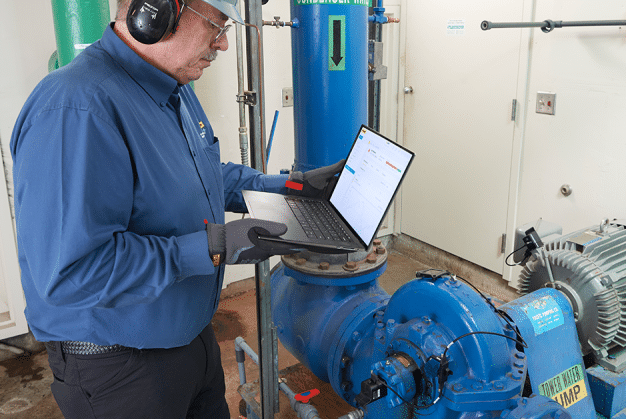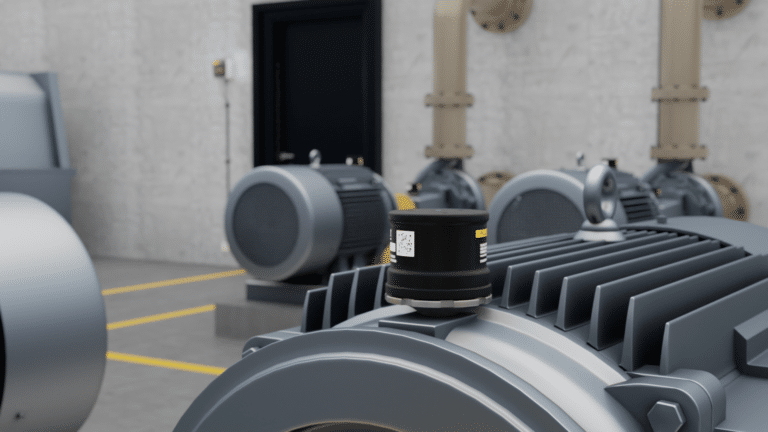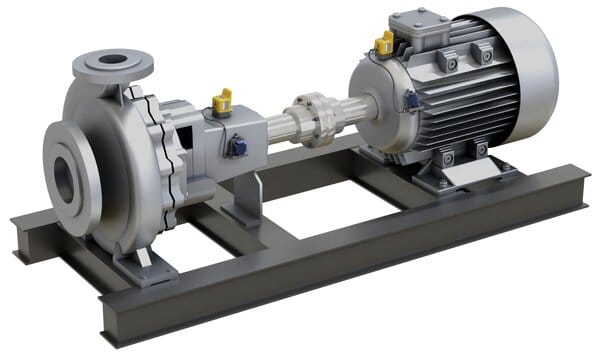Wireless vibration monitoring typically happens as part of a predictive maintenance strategy. With wireless vibration monitoring, maintenance teams place Industrial Internet of Things (IIoT) sensors on important machines to collect vibration measurements over time and catch problems. Depending on the vibration sensor’s capabilities, it might detect, analyze, and even diagnose machine faults.
If left unchecked, abnormal machine vibration in assets like drive motors and driven devices can cause operational problems and severe damage. Wireless vibration monitoring can help prevent:
• Excess component wear that reduces equipment lifespan
• Risks to personnel safety
• Power consumption that could cause product quality issues
• Unplanned downtime and production loss

What is Vibration Monitoring?
Vibration monitoring devices measure the amplitude, frequency, or intensity of the vibrations emitted by any rotating piece of machinery, including motors, fans, pumps, and more.
Every piece of rotating equipment has its own vibration signature. A machine’s baseline, healthy vibration patterns can be determined by taking a reading of the equipment when it is in optimal running condition.
Once the normal baseline is determined, maintenance teams can use either handheld vibration meters or vibration monitoring sensors affixed to key points on the machine to measure the machine’s vibrations over time. If the vibration pattern changes, it’s probably because there is a fault in the machine. Vibration monitoring can pick up on even minor defects in your machinery, giving your maintenance teams plenty of time to make repairs before the problem worsens.
Vibration monitoring sensors can measure vibrations continuously and alert you to any changes in the machine’s condition in real-time. Wireless sensors can send that data straight to your smartphone or tablet. You can also use data analytics software to analyze your vibration data over time and make smart predictions about your machine’s health, performance, and future maintenance requirements.
How is Vibration Measured?
Technicians measure vibrations near the machine’s bearings. That’s because the bearings are often the first location where rotating machines show signs of defects or damage. If your technicians are using a hand-held vibration meter, they will take vibration readings on a regular, scheduled basis.
If you’re using a vibration sensor, the sensor will monitor vibration continuously, giving you the opportunity to identify issues in between scheduled maintenance visits. Depending on the model, you can also stream your data to a data analytics program so that you can analyze your vibration data in real time.
There are many different types of vibration sensors, but the most commonly used sensor is an accelerometer. Today’s vast majority of vibration sensors are accelerometers, which measure acceleration of forces acting on an object and produce electrical signals proportional to forces that they are measuring.
What Machine Faults Can be Caught with Vibration Monitoring?
Vibration monitoring can point to variety of issues, including early bearing wear, shaft misalignment, loose parts, and more. Abnormal vibration patterns can also indicate components that were installed incorrectly. Changes in your machine’s vibration patterns can also indicate problems with the gear box or the coupling. They can also be a sign of hairline cracks in your machinery.
Vibration sensors can catch even tiny changes in vibrations that are too subtle for humans to perceive by touch or sight. Modern sensors are also small enough to be placed in hard-to-reach locations, so that you can measure vibrations from different machine parts that are difficult to access with a handheld device. With sensors monitoring multiple areas of the machine, you can easily identify where the problem is occurring and quickly diagnose the issue. Once you know where the source of the trouble is, your technicians can go in and repair the problem before it becomes serious.
What is a Wireless Vibration Monitoring System?
Wireless vibration monitoring systems use multiple vibration sensors, tools, and devices to take key vibration measurements. Tracking excess vibration in rotating equipment is critical to identifying machine faults early, so maintenance teams can keep plants and facilities up and running.
By studying an asset’s vibration measurements, even non-experts can catch machine imbalance, looseness, misalignment, or bearing wear.

Vibration Sensors for Condition Monitoring
Not all vibration sensors have the same condition monitoring abilities – some collect more detailed readings than others. However, not all machines need detailed vibration readings.
Today, there are two common approaches to wireless vibration monitoring: screening vibration sensors and analysis vibration sensors.
Analysis vibration sensors are used for vibration monitoring on important, tier II machines. Analysis vibration sensors collect bursts of high-resolution data and they can detect the most common machine faults.
Screening vibration sensors are best suited for wireless vibration monitoring on standard machines – those that aren’t production critical – to detect basic machine health, like is the asset doing good or bad.
Beyond wireless vibration monitoring, there are also wired vibration sensors, like Prüftechnik’s VibGuard. These wired vibration sensors can collect constant, high-resolution vibration measurements to support extremely detailed data analysis. They work well for vibration monitoring on complex and production-critical machines, however, these advanced sensors require advanced training.
So, in many cases, maintenance teams choose wireless vibration monitoring.

Fluke 3563 Analysis Vibration Sensors
Like screening vibration sensors, analysis vibration sensors also continuously monitor machine vibration data. However, analysis vibration sensors provide a deeper dive into machine health.
The extended data from these wireless vibration monitors gives maintenance teams the ability to identify the exact source, or root cause, of a mechanical problem.
The Fluke 3563 Analysis Vibration Sensor is a great example of this kind of high-accuracy, wireless vibration sensor. The robust vibration sensor leverages powerful piezoelectric technology to collect asset performance and fault data continuously, streaming it to the cloud.
Maintenance technicians, regardless of experience, gain insights into machinery health and capacity from connected software. After users program software to recognize each machine’s specific vibration signal, eMaint condition monitoring will identify the four most common machine faults: imbalance, misalignment, looseness, and bearing damage.
Fluke 3563 and eMaint Condition Monitoring Top Features:
- Displays overall asset condition with summary-level data visible by location
- Monitor assets at a glance through data analysis visualizations, including:
- Velocity and acceleration, respective bands
- Temperature
- Overall bearing severity
What are the Benefits of Using a Wireless Vibration Monitoring System?
Machine vibration screening and analysis systems are both essential parts of successful condition monitoring and predictive maintenance program. Choose from the available vibration solutions to fit your needs. Each offers different capabilities depending on the sensor. Also choose your vendor for their experience and expertise, giving preference to those that support your program after the sale.
Comprehensive solutions, like the Fluke 3563 Analysis Vibration Sensor systems, are a complete package. Deploying them in your organization improves your vibration program for every plant and facility asset.
Wireless Vibration Monitoring Services and Support
Prüftechnik, part of the Fluke Reliability family, offers a wide range of Remote Condition Monitoring services and support to improve your maintenance program. From training to post-purchase setup, our remote condition monitoring experts can help you reduce unplanned downtime and prevent potentially catastrophic failures, using our vibration solutions to improve asset reliability.
Developing a predictive maintenance vibration monitoring program doesn’t have to be complex, time-consuming, or expensive. You can start small with a pilot program.
Remote Condition Monitoring and Onsite Services
- Asset-to-sensor analysis
- Network and schedule configurations, commissioning, and installation
- Vibration training on core principles and taking data-based actions
Schedule a Call with a Wireless Vibration Monitoring Specialist
You can schedule a consultation with a Fluke Reliability expert to answer your wireless vibration monitoring and vibration sensor questions. If you’re interested, please request a demo today.






